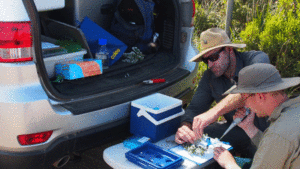
Coastal Victoria. Identifying, sampling, testing and mapping individual Leptospermum plants displaying desired traits for subsequent collection and propagation. (October 2015)
[These plants are growing in infertile alkaline coastal sand pH 8.0 – 9.0]
There are three levels of genetic selection;
ERA Nurseries is no longer selling level 1 stock of Leptospermum scoparium or Leptospermum polygalifolium
- Level 1. Provenance level describes where the seed is collected from communities of plants of any species that by natural selection have adapted to local conditions which could include low rainfall, front-line coastal exposure, heavy frost, strong wind etc. These populations have been tested at a reconnaissance level for DHA and sugar.
- Level 2. Seed collected from individual plants that have displayed, or have been tested for a desirable trait such as DHA and sugar levels. (Dihydroxyacetone; the precursor to MGO in honey)
- Level 3. Seed collected from a seed orchard or a controlled pollination program where multiple clones of superior individuals have out-crossed with each other to produce a genetic gain in the resulting progeny.
One of the things that characterise the Leptospermum tested so far is the varying levels of DHA within any wild population of plants in the field. The below graphic shows the difference between the lowest DHA and the highest in those two species of Leptospermum tested.
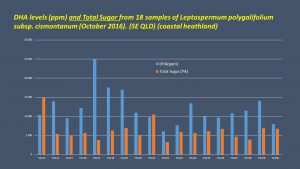
(Graphic copyright. EB Allender)
A similar outcome was found in populations of both Leptospermum scoparium and Leptospermum polygalifolium so it may be assumed that this characteristic may also be found in other Leptospermum species.
In January 2016 a detailed nectar sampling program of Leptospermum scoparium was undertaken in the Grampians region in Western Victoria. It was found that the lowest DHA recorded was <1,000 DHA ppm and the highest was >5,000 DHA ppm with a spread of values in between averaging around 2,000 DHA ppm. This is consistent with the averages reported from Tasmania and New Zealand.
Other factors were also considered in the selection process including individual plant form, health, vigour flower size and flower profusion and most importantly total sugar which is an indicator of nectar flow.
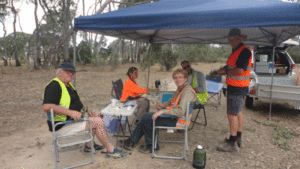
Sampling nectar in the Grampians region in January 2016 (seated front. Ted Allender with Simon Williams from the University of the Sunshine Coast . Seated rear, Dr Kate Delaporte and Nick Timbs from the University of Adelaide)
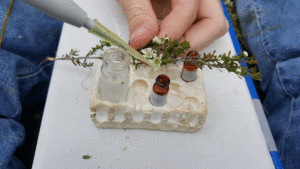
Seed has been collected from the 10% highest yielding individuals. This seed has been bulked and is being propagated for plantation applications.
Disinfected plant material taken from selected high-activity individuals (below) are propagated and grown out in the nursery ultimately for the production of improved seed.
In one instance material has been collected from 18 (out of 200 tested) and these plants have been incorporated into a clonal seed orchard/seed production area designed with single rows of 4 clones (x 18) randomised over 3 replications. (pictured below) Once flowering, bees will cross-pollinate the plants throughout the seed orchard resulting ultimately in a significant genetic gain of the desired trait which is elevated DHA levels in the progeny.
Trial Plot and Seed Orchard



Seed orchard soon after planting in August 2016 (above)


The same perspective 16 months later in January 2018.
This project was impacted by livestock damage on a couple of occasions during this period. Despite that, some of the clones attained a height >2m with light flowering evident throughout. No irrigation throughout a very dry summer.
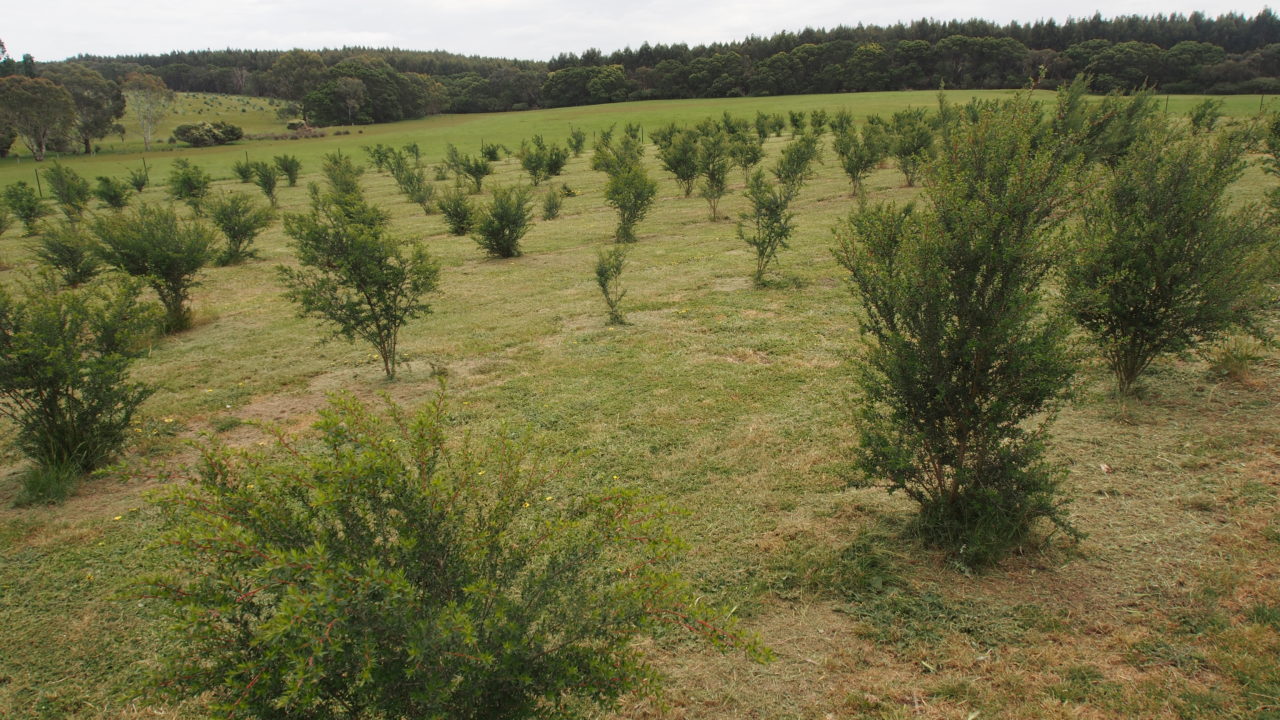
Same perspective. November 2018.
Two years and two months from planting. The first full flowering is expected in December and January 2018. Surprisingly, there seems to be little (if any) difference in the time it takes to flower for seed-grown plants compared to cutting-grown plants.
Seedlings grown from this genetic improvement program will be provided to plantation projects in due course as well a base for the next level of improvement.
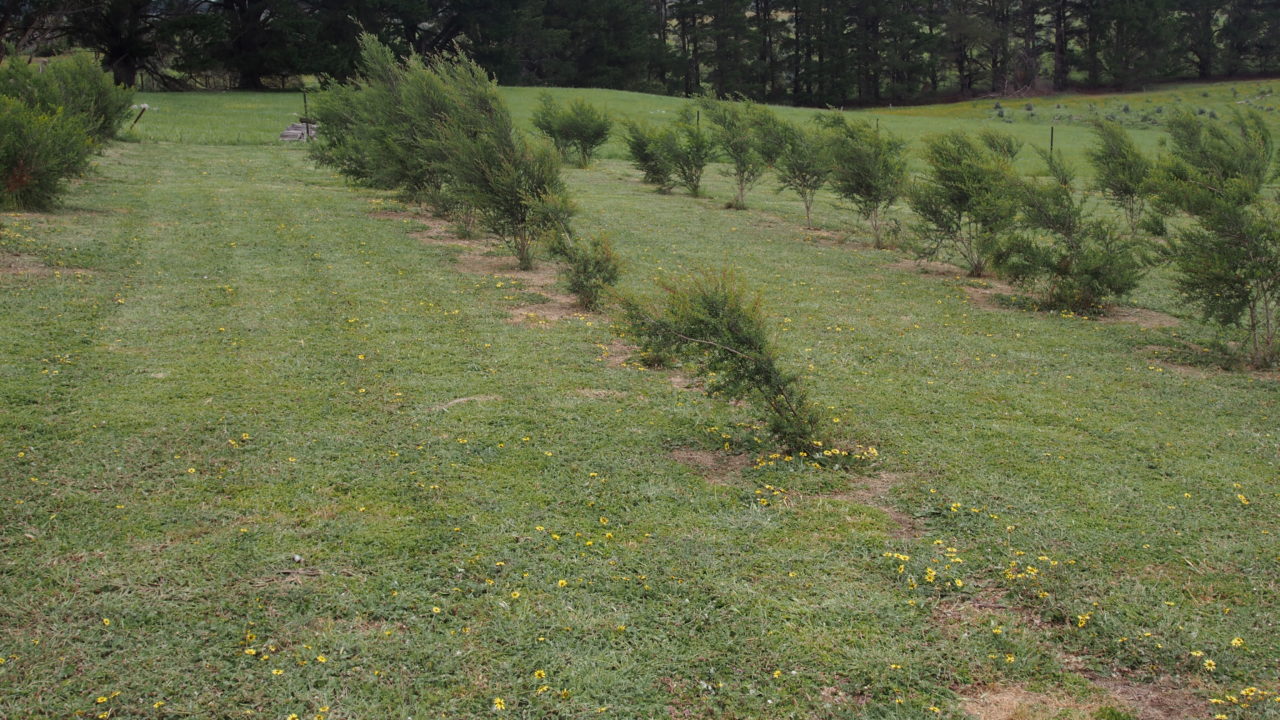
This trial has 18 clones in rows of 4 replicated randomised 4 times. This allows the for the minimisation of local environmental conditions such as prevailing wind, variations in soil quality etc over the site. Each clone can then be assessed and compared on a more equal footing. It can be seen clearly, for example, that the 4 clones pictured mid-frame (whilst having higher than average bioactivity) do not perform when put into cultivation. The 4th set immediately behind them have grown away and show good form and uniformity. These would be selected for ongoing breeding whilst the foreground clones would be discarded.
This work is essential because the additional selection of these other essential parameters cannot be determined in the field amongst wild populations because there is always the uncertainty of the actual age of individuals. At least with a trial such as this it can be certain all of the individuals are the same age and can be regularly observed.
Similar plant selection and breeding work will continue with this and other  Leptospermum species, particularly L. polygalifolium.
This work is continuing currently in the security of the Nursery rather than the ‘open field’ approach described above. The above trial and seed production area will be pollinated by bees at a time (January) when there is very little else flowering and certainly no species from Myrtaceae family. (see ‘Moving Towards Level 3 Genetics’)